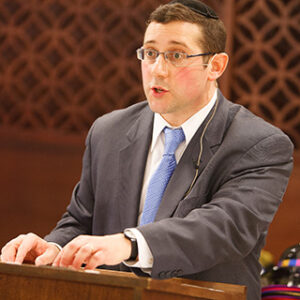
Babylonian Talmud Shabbat 20b
Jul 18, 2009 By Marcus Mordecai Schwartz | Text Study
Spoken words are central to Jewish thought, religion, and practice. Our Sages believed that the world was created with divine utterances and their Torah was transmitted from mouth to ear. The word mishnah probably means recited teaching. The Mishnah was almost certainly imported to Babylonia in an entirely oral form. But what would happen if the meaning of an obscure Hebrew word in the Mishnah was forgotten? This is exactly the situation that motivates Rabin and Abbaye’s Aramaic dialog in the above conversation.
Read More
Babylonian Talmud Shabbat 18a
Jul 11, 2009 By Marcus Mordecai Schwartz | Text Study
My selection this week begins with an ellipsis. Preceding this source are a range of regulations allowing passive forms of labor that begin before the commencement of Shabbat to continue throughout Shabbat. For instance, the Talmud allows us to place clothing into a solution of dye or set nets to catch fish just before Shabbat begins and then to reap the rewards of our labors after Shabbat, even though the clothes took the dye and the fish were caught (without human action) on Shabbat. Our source (most likely a second-century text from Eretz Yisra’el) presents an exception to this general rule: One may not place unmilled wheat under the stones prior to Shabbat and allow the water or wind to grind them over Shabbat. The question is why should this be prohibited, when the dye and traps are permitted.
Read More
The Torah’s Middle Path
Jul 11, 2009 By Daniel Nevins | Commentary | Pinehas
Is there ever a discernible gap between God’s morality and the Torah, or is the Torah itself our only window into the realm of divine values? Put another way, is it permissible for a reverent Jew to challenge the morality of a law, and to base this challenge on his or her own understanding of justice and thus God’s will?
Read More
Babylonian Talmud Shabbat 17b
Jul 4, 2009 By Marcus Mordecai Schwartz | Text Study
The Sages inherited a system of Shabbat observance that proscribed carrying any item of significance from one domain to another. Money is obviously of great material significance in our lives, and we are to leave it safely at home as we travel on Shabbat. But what if, through no fault of our own, we are still on the road with money in our pockets when Shabbat begins. We have seen the solution before: Mishnah Shabbat 24:1 allows us to place the money with a non-Jewish companion for the duration of the sabbath. In our source above, Ula gives us more information about the origins of this solution.
Read More
The Sin of Moses
Jul 4, 2009 By Deborah Miller | Commentary | Balak | Hukkat
Everyone knows how Romeo and Juliet ends, and yet we still cry when they die. The same is true of the first of the two Torah portions we read this week, Parashat Hukkat/Balak. In this portion, we learn that Moses will not enter the Promised Land. We have heard or read this story every year, and yet we are still upset, still angry that, on the threshold, Moses is denied admission to the Land to which he has been leading the Israelites for forty years.
Read More
The Desire for Power
Jun 27, 2009 By Jonathan Milgram | Commentary | Korah
This week’s Torah reading, Korah, has a central theme: encroachment on the Tabernacle and its related punishments. No fewer than four separate uprisings are recorded in our reading, all associated with Korah: (1) the Levites against Aaron and Moses, (2) Dathan and Aviram against Moses, (3) the heads of the tribes against Aaron, and (4) the whole community against Moses and Aaron. The punishments for at least two of these rebellions are clearly documented: Dathan and Aviram are swallowed up by the ground and the tribal leaders are burned by a divinely sent fire. Korah’s fate, however, is not as clearly stated. It may be that he dies with the tribal heads or that he is consumed by the earth with Dathan and Aviram.
Read More
Babylonian Talmud Shabbat 44a
Jun 27, 2009 By Marcus Mordecai Schwartz | Text Study
One of my first memories of Shabbat is a vision of the beauty of the Shabbat candles. Accompanying this memory is the first Shabbat restriction that I recall learning: “We don’t touch the Shabbat candles or move them.” As I noted in an earlier piece, for our Sages, the Shabbat lights are a way of ensuringshalom bayit—household harmony.
Read More
Babylonian Talmud Shabbat 128b
Jun 20, 2009 By Marcus Mordecai Schwartz | Text Study
As we move into the summer months, I wanted to revisit this source that we saw earlier in the year. As we mentioned the last time we saw it, this source limns the boundaries of our responsibility to protect our animals on Shabbat. According to this source, one may violate a Rabbinic commandment to preserve an animal from suffering on Shabbat. Here we see that the destruction of the blankets and pillows (usually forbidden on Shabbat) is legitimate if the purpose is to preserve the animal from harm.
Read More
Seeing Life in 3D
Jun 20, 2009 By David M. Ackerman | Commentary | Shelah Lekha
Last Sunday, in honor of his seventy-fifth birthday, my father invited his eight grandchildren and their parents to join him on a guided visit of Ellis Island. Toward the conclusion of our tour, having taken in the key sites, we gathered outside, just beyond the stairs that led millions of immigrants from the processing hall and medical examinations to the ferries and barges that took them to Manhattan and beyond. At that spot, my dad shared with his grandchildren the story of his grandfather’s arrival in America, 110 years prior: in 1899, Nathan Mendelsohn, an eleven-year-old native of Iasi, Romania, traveled by ship from Rotterdam to New York.
Read More
Lessons From the Wilderness
Jun 13, 2009 By Arnold M. Eisen | Commentary | Beha'alotekha
Powerful images of authority dominate this week’s Torah portion. How do these images relate to contemporary readers who—despite our distance from the events in the wilderness—remain part of the people Israel’s progress toward the Promised Land?
Read More
Babylonian Talmud Shabbat 12a
Jun 13, 2009 By Marcus Mordecai Schwartz | Text Study
The two first-century schools of Rabbinic thought, Beit Shamai and Beit Hillel, crop up quite often in the Talmud. Here Rabbi Shimon b. Elazar, an early third-century Sage, quotes their positions. This dispute between the two schools goes to the heart of what the experience of Shabbat should encompass. On the one hand, as I mentioned last week, there is the principle that Shabbat is a time that should be free from worry.
Read More
Babylonian Talmud Shabbat 12a-b
Jun 6, 2009 By Marcus Mordecai Schwartz | Text Study
Shabbat and prayer are deeply connected in the mind of the contemporary Jew. Shabbat is the time when many of us engage in public prayer each week. Though most Conservative synagogues have a weekday minyan, usually its attendance is much smaller than that of the Shabbat service. So it is surprising when we discover that our Sages frowned on the practice of making personal requests of God on Shabbat.
Read More
Becoming Builders
Jun 6, 2009 By Marc Wolf | Commentary | Naso
I imagine that all of us have noticed that the only thing unequivocally going up right now is the number of pundits—professional and amateur—who are chiming in on what it is that economic indicators seem to be telling us. At kiddush in my shul, in airports, on television, and certainly on the Internet, anywhere you turn there are people pontificating about where the economy is headed. While you will certainly hear no projection here, in my own reading what caught my eye were two economic indicators that focus specifically on construction and building.
Read More
Babylonian Talmud Eruvin 20a
May 30, 2009 By Marcus Mordecai Schwartz | Text Study
We’ve seen the idea that carrying from one domain to another is prohibited on Shabbat. This idea is usually (though not always) expressed as “carrying from a public to a private domain” or vice versa. Here we see an additional question rising out of this basic law: What if one stands in one domain and imbibes water from another domain? Is one’s body another domain? Is it part of the domain that one’s feet are in? Is it part of the domain that one’s head is in? Perhaps the Shabbat domains end altogether at one’s lips? And what is the spiritual message about the Shabbat and the body that we are supposed to take away from this?
Read More
Babylonian Talmud Shabbat 86b
May 23, 2009 By Marcus Mordecai Schwartz | Text Study
On Shavu’ot we recreate the revelation of Torah. Though we see in the Torah that revelation occurs over a long period, and in many places in the wanderings of the Israelites, nonetheless, the ultimate revelatory model in the Bible is the giving of Torah at Mount Sinai / Horeb in Exodus 20. It is this revelation we seek to commemorate on Shavu’ot. However, there are two unexpected things about this festival. It has no fixed date in the Torah—instead it is linked with the barley harvest; and second, the Torah never explicitly connects it with the Sinai event—though when we calculate the dates given in Exodus 19, the revelation at Sinai (or at least the surrounding events) must have coincided with the regular dates of the festival, early in the month of Sivan, at the time of the barley harvest.
Read More
Counting Ourselves As Israel
May 23, 2009 By Leonard A. Sharzer | Commentary | Bemidbar
Sefer Bemidbar, the Book of Numbers, which we begin reading this week, opens with the taking of a census. After the rather arcane matters we have been reading about in recent weeks—the sacrificial cult, laws of purity and impurity, skin eruptions, bodily discharges, and so on—the monotony and repetitiveness of this week’s parashah comes almost as a relief. The chieftains of each tribe are named, and an identical formula is recited, concluding with the number of men over the age of twenty—fighting men—in each tribe. For this is not a census of the entire people, rather it is an accounting of those who will make up an army to cross the desert. The Israelites have just celebrated the first anniversary of their liberation, and they are about to embark on a journey that will last thirty-eight years, although they do not know that at the time of the census. They are forming an army to take the population on what should be a short sojourn to the Promised Land. That they should form an army to cross the desert is not surprising; but, we may ask, why the apparent preoccupation with numbers?
Read More
Rashi’s God and Ibn Ezra’s God
May 16, 2009 By Walter Herzberg | Commentary | Behar | Behukkotai
I am in the midst of reading Michael Fishbane’s recently published book Sacred Attunement: A Jewish Theology. Especially compelling, from my perspective, is the emphasis he places on experiencing the act of biblical interpretation which “is understood to foster diverse modes of attention to textual details, which in turn cultivate correlative forms of attention to the world and divine reality” (page xi). To quote my student Rachel Isaacs (rabbinical student in my Advanced Exegesis class), “Fishbane articulates most clearly the reason why rabbinical students are engaged in the types of learning they are. Close reading [of the Torah text] is not a useless skill or a rite of passage. It forces us to have an intimate, thoughtful, and challenging relationship with the text. As a result, we acquire new revelations through the process of encountering the text as much as we do from the content itself.”
Read More
Babylonian Talmud Shabbat 113a
May 16, 2009 By Marcus Mordecai Schwartz | Text Study
We have seen this source before. When last we saw it, I mentioned that some of our Sages felt that objects which could not be used on Shabbat in any permitted way should be utterly outlawed for the entire twenty-five-hour period of Shabbat. This is the prohibition that came to be known as muktzeh(things placed to the side). If an object has no use on Shabbat, it is in this category and, generally, may not be picked up and moved to another location on Shabbat. This is different than the prohibition on carrying from one domain to another, which we have been discussing the last few weeks. This later prohibition, termed hotza’ah (literally, carrying out), applies to all objects.
Read More
Caring for Our Parents
May 9, 2009 By Judith Hauptman | Commentary | Aharei Mot | Kedoshim
The third verse of Parashat K’doshim says, “Ish imo v’aviv tira’u” (One should revere his mother and father) (Lev. 19:3). The same mandate appears twice as the fifth commandment, “Kabed et avikha v’et imekha” (Honor your father and your mother) (Exod. 20:12; Deut. 5:16). Honoring parents was considered a virtue in the Roman world. Parents took care of their children, and children were expected to return the favor when parents grew old. But Rome did not create a legal obligation to care for parents, and a child who refused to do so could not be compelled by the courts.
Read More
Mishnah Eruvin 10:1
May 9, 2009 By Marcus Mordecai Schwartz | Text Study
Our Sages considered it proscribed labor to carry any burden of value from one domain to another on Shabbat. As we noted last time, it is not the weight of an item that constitutes its significance in the Rabbinic mind, but the value that people ascribe to it. Some items have value because of their utility (food, for example), while others have value due to their sacred nature. One such sacred item is a pair of tefillin. In this mishnah, we see that one is prohibited from carrying tefillin from one domain to another (here, from the outdoors to indoors) on Shabbat, even to protect them from harm. Rather, the mishnah suggests, put on the tefillin and walk indoors. In this way, one preserves the sacred object without violating Shabbat.
Read MoreSUBSCRIBE TO TORAH FROM JTS
Our regular commentaries and videos are a great way to stay intellectually and spiritually engaged with Jewish thought and wisdom.




